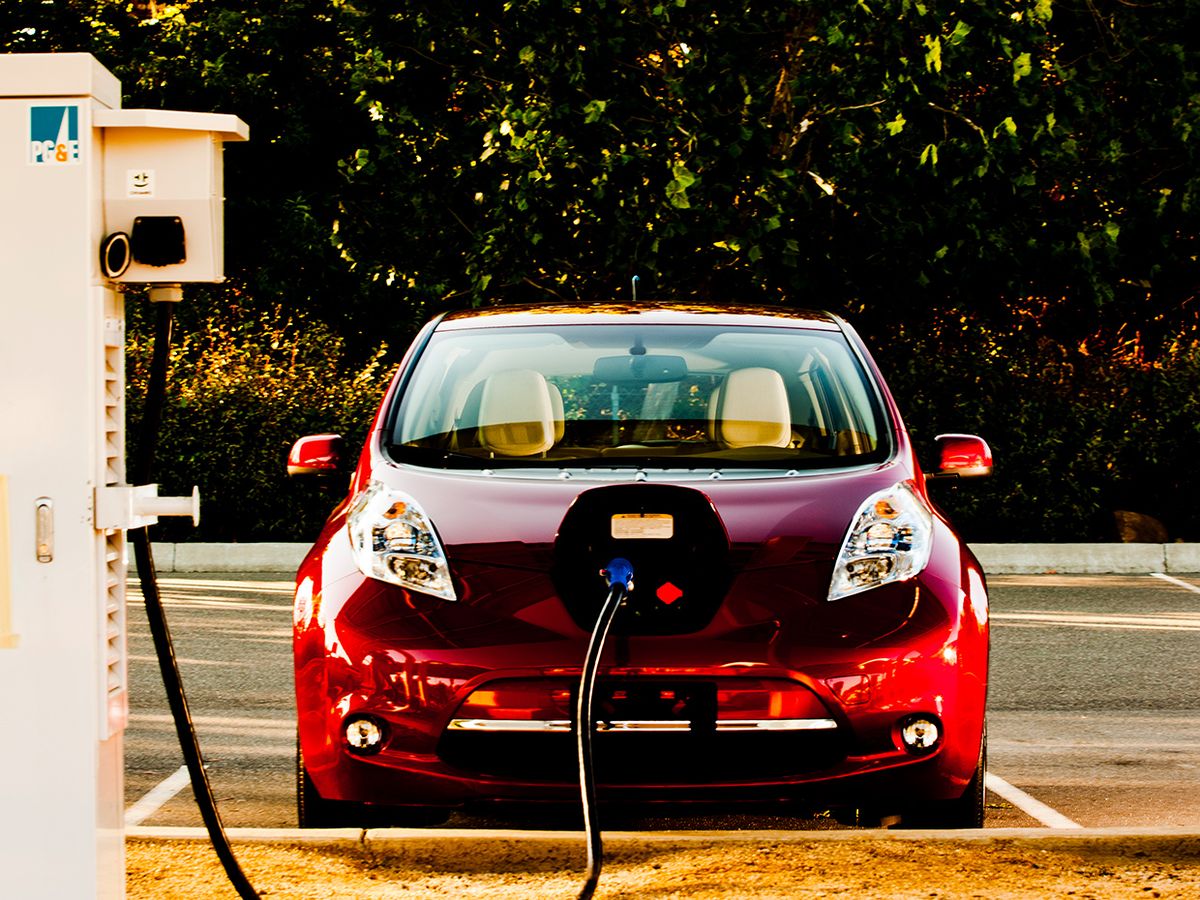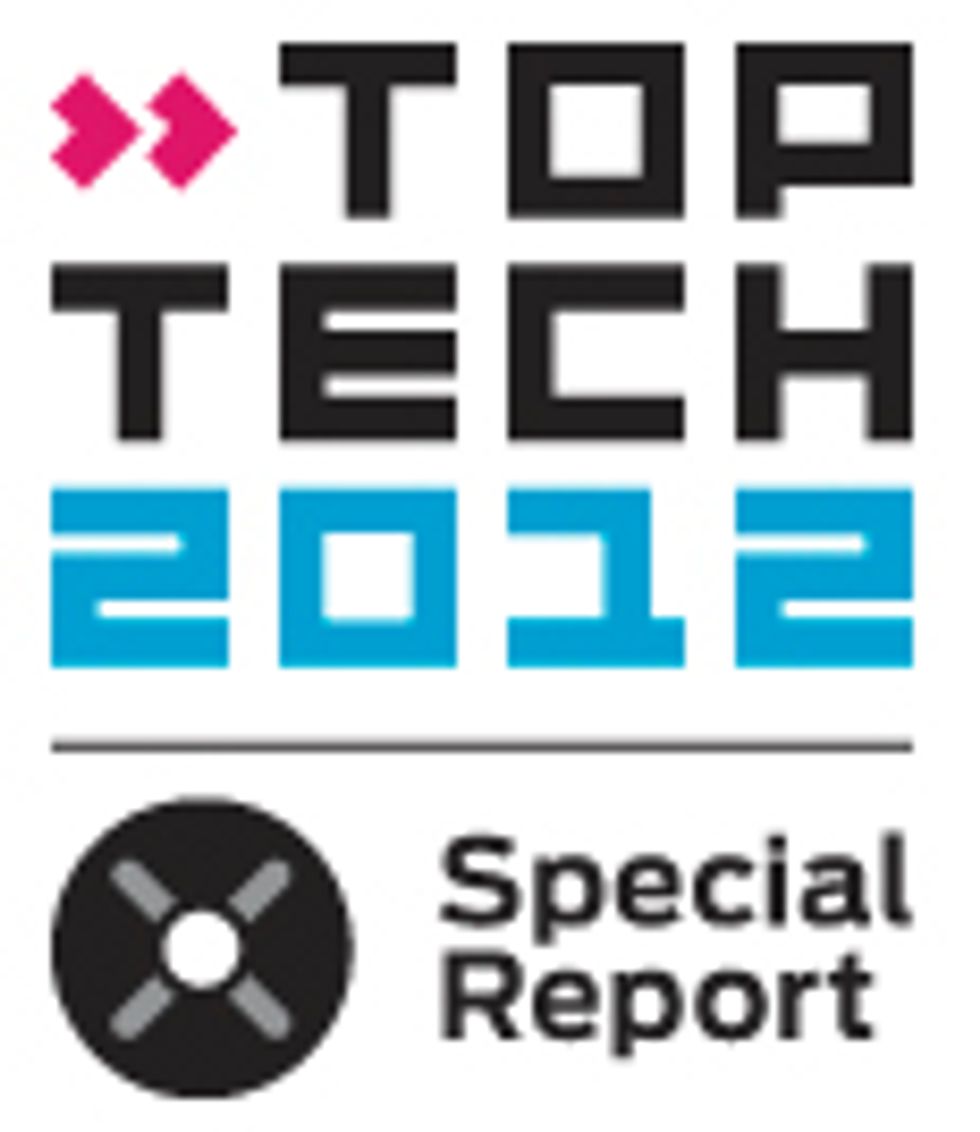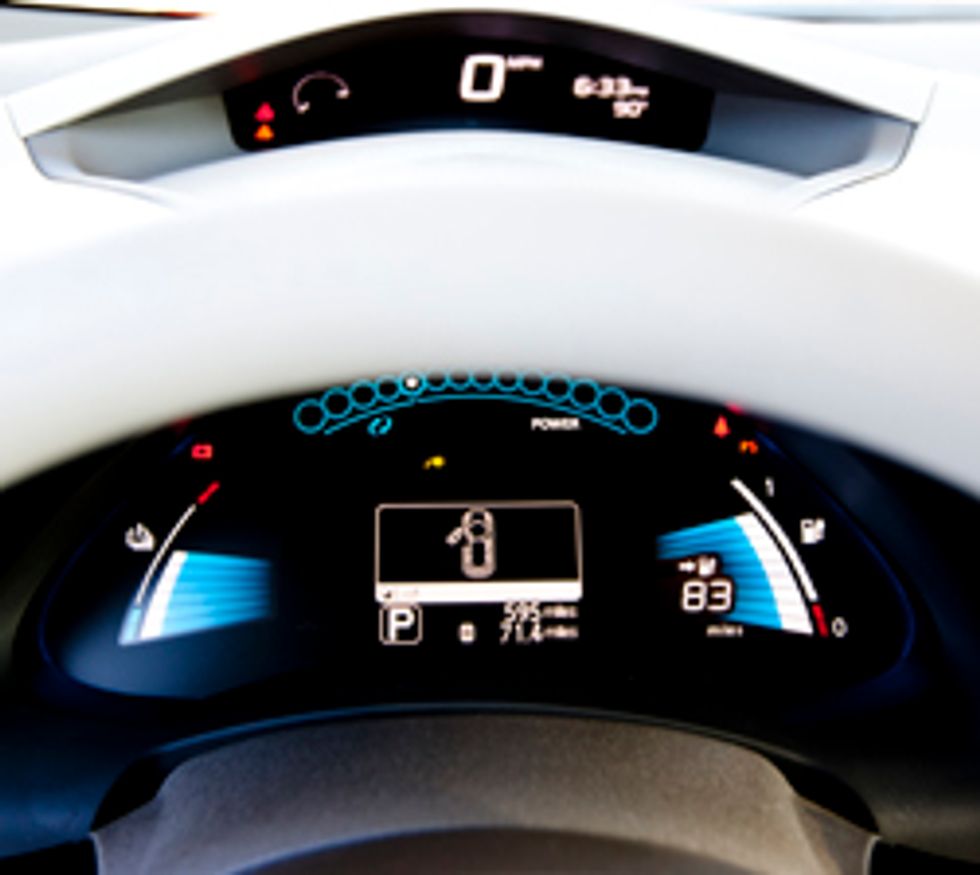Charge of the EV Brigade
2012 will test the feasibility of EV charging stations

In a cloud of car exhaust during a Friday rush hour, I’m humming over San Francisco’s Golden Gate Bridge in an all-electric, tailpipe-free Nissan Leaf. I’ve plotted a course for Vacaville, 88 kilometers (55 miles) north, known for its sprawling outlet mall. However, I seek not a shopping retreat but an eco-electric enclave, for this city is in the vanguard of a government-subsidized drive to build the first network of public electric-vehicle charging stations in the United States.
Throughout this year and into 2013, the top organizations in EV charging technology will be wrapping up projects backed by more than US $130 million in federal stimulus money and Department of Energy grants. And with thousands of public chargers coming on line, Vacaville’s beta-scale program joins the latest, politically charged controversy over the electric car: Is public charging a necessary spark to ignite mass-scale EV adoption?
Surprisingly, many key players in the automakers’ EV programs are unenthusiastic about the rollout. Many of them insist that most buyers will charge at home first, workplace second, and rarely, if ever, need a public fill-up. “We see public charging as a nice-to-have, not a need-to-have,” says Aaron Singer, product manager for electric vehicles at BMW.
Yet proponents say that public charging is as critical as the cars themselves. Nissan is a prime example. “As a company, strategically, we look at public charging as an accelerator to EV adoption,” says Mark Perry, Nissan’s chief product planner for North America.
Without public charging, “EVs will be tethered to homes, a niche application,” says Don Karner, an electrical and nuclear engineer who is cofounder and president of ECOtality, a San Francisco—based charging company. “We can do better than that.”
Vacaville’s pioneering effort also spotlights the challenge of birthing a nationwide EV infrastructure that might dent Big Oil and its vast network of more than 100 000 U.S. gas stations. It’s a system that has trained drivers to expect, without a second thought, to fill up in 3 minutes flat and drive hundreds of kilometers before having to do it again.
I’ve come to Vacaville to plug in to one of the United States’ first DC—sometimes called Level 3—fast chargers. This 480-volt, 50-kilowatt beast can fill my burgundy Leaf to 80 percent capacity in 30 minutes. My plan is to drive all weekend without using a drop of gasoline or spewing a whiff of tailpipe pollution. That includes my run to Vacaville’s high-powered charger, strategically perched between San Francisco and Sacramento, allowing EV owners to bridge the gap between two major cities. EVs can still use a standard 120-V household plug, but charging takes up to 24 hours on that Level 1 power.
Home base for the weekend is the Parc 55 Wyndham Hotel in San Francisco’s Union Square, among a handful of area hotels offering free fill-ups on Level 2 stations. These 240-V AC units are simply heavy-duty versions of the home stations used by the Leaf and other models. Delivering 3.3 kW per hour, they can fill a Leaf’s 24-kilowatt-hour battery in 7 hours or the 16-kWh battery of a Volt plug-in hybrid in 3.5 hours.
At the hotel, I pull up to the free JuiceBar brand charging station, created by BMW Group’s DesignworksUSA, and connect its cable to the Leaf. Two hours later, after catching up on e-mail, I’ve topped off the battery, leaving me range to spare for my run to Vacaville.
Level 2 is the go-to technology for 95 percent of home and commercial stations coming on line. And the latest Level 2 chargers run at 6.6 kW, charging in half the time as the 3.3-kW units. The charger for the $39 995 Ford Focus Electric, hitting the market right now, is the first 6.6-kW unit for home use. Manufactured by Leviton and sold and installed for $1499 through Best Buy, the charger can restore the Focus’s 160-km driving range in 3.5 hours.
“Four hours or less is the sweet spot,” says Richard Lowenthal, chief technical officer of the California-based charging company Coulomb Technologies. “Everyone works or sleeps more than that.”
The biggest installer of Level 2 chargers is ECOtality, which is spending $230 million, including $115 million in Department of Energy grants, to install nearly 15 000 Blink brand charge stations in six states and the District of Columbia, most of them Level 2s.
ECOtality manages the DOE-sponsored EV Project, which is giving 8600 EV buyers free chargers and letting companies collect real-time feedback on driving patterns and energy usage. The project is also adding about 5000 public chargers, including 225 fast chargers in 18 major metro areas, including Houston; Los Angeles; Phoenix; Portland, Ore.; San Francisco; the Tennessee Triangle (Nashville, Knoxville, and Chattanooga); and Washington, D.C.
So far, a recharge is typically free at any of the program’s public charging stations. But nobody expects that to last forever. So charging companies are looking to put their chargers at places such as big box stores, where they can charge for a charge, thereby flourishing without government subsidies. It won’t be easy: Although Level 2 chargers cost only $1500 to $3000, a DC fast charger, capable of 80 percent charging in 30 minutes, can cost up to $50 000, including installation. Utilities may charge exorbitant rates to access quick-charge power, dampening prospects for station owners and users. But to spur adoption, Nissan recently released a groundbreaking compact 480-V quick charger that will sell for $9900, plus installation.
“Our competition isn’t gasoline, but affordable home electricity,” says ECOtality’s Karner. In some states, home chargers will enjoy discounted off-peak nighttime rates as low as 5 cents per ¬kilowatt-hour. Even at the national average of 11 cents, a Leaf can cover 160 km for about $2.75. Compare that to the $16 you’d spend in a typical car that runs at 9.4 liters per 100 km (25 miles per gallon) at $4 per gallon. Somewhere in between is the profit point for station hosts, with drivers paying partly for service, partly for a convenient parking space.
Batteries last longest and perform best when they avoid rapid cycling and extremes of hot and cold. Yet the faster they charge, the more heat is produced. Engineers face a balancing act: how to stuff batteries quickly while assuring that they’ll hold up for eight years and 100 000 miles (161 000 km), as most warranties stipulate.
The trick is managed with smart electronics. chargers communicate with cars’ onboard chargers via digital signals to monitor state of charge and battery temperature, adjusting the power level as needed. Battery systems also cool themselves: For instance, the Volt battery circulates liquid coolant around each of its 288 cells.
For household and Level 2 ¬chargers, rectifiers onboard the car convert grid current into DC. DC chargers stuff juice directly into the battery, but at an industrial strength—roughly 480 V, 100 amperes, and 60 kW.
To preserve their batteries, EVs are programmed to cut off fast charging at 80 percent capacity. Lithium-ion car batteries have yet to establish a record, but Nissan suggests that constant quick charging will reduce capacity by 1 percent per year beyond normal levels. The company is developing a charger based on work at Kansai University, in Japan, that replaces a carbon electrode with one made from tungsten and vanadium oxides, allowing 10-minute charges without harming batteries.
But for now, 30 minutes is the target—one that some experts say poses no big challenge to gasoline cars.
“People misunderstand what ‘fast’ charging is going to deliver,” says Britta Gross, director of global energy systems and infrastructure commercialization for General Motors. “A fast-charging network doesn’t turn an EV into a long-range vehicle.”
What fast chargers can do, though, is ease the oft-cited problem of “range ¬anxiety”—the dread of running out of juice and being stranded miles from a plug.
and
100 000 miles
Auto battery warranty goal
“To make electric transportation useful, we have to extend range,” Karner says, “and adding infrastructure is more cost-effective than adding heavy, expensive batteries to the vehicle.”
Sounds good, in theory. But stations could gather dust, awaiting customers who never arrive. “The restricted parking spot with a charger that sits day after day unused will give the industry a black eye,” Gross predicts.
I don’t have 7 hours to blow at Vacaville’s outlet mall, but the quick-draw DC charger fortunately awaits, in a park-and-ride lot behind a Sonic Drive-In. I’m met by Vivek Narayanan, electric and natural gas vehicle product manager for Pacific Gas and Electric Co. in San Francisco. He pulls up in a Chevy Volt and plugs in to one of six Level 2 units alongside the big Eaton DC charging unit. We’re the only customers.
Narayanan unlocks the DC charger, and I connect its unwieldy plug—roughly the size and weight of a power drill—to the Leaf’s fast-charge port, a $700 option on the $36 050 car.
The unit rattles and hums, and then...nothing. The charger can’t establish communications with the Leaf, and the screen flashes an error message. It wouldn’t be the first time that I’ve encountered an inoperable public station.
After a phone call to a PG&E tech, we get it working. The Leaf sucks up a charge in 32 minutes, barely enough time to grab a burger at the nearby drive-in.
Japan currently leads the way in EV fast charging, with nearly 1000 public units (compared with fewer than 100 in Europe). Tokyo Electric Power Co. and some Japanese automakers set the standard—followed by the makers of almost all other fast chargers, mine included—called CHAdeMO, which loosely means “charge to move.” But the U.S.-based SAE International is readying a new standard that modifies today’s J1772 connector to incorporate household, Level 2, and high-¬powered DC charging within a single “combo” connector. The SAE’s proposal is backed by American and European automakers, which prefer the new plug and perhaps don’t mind sticking it to Nissan, which was first to the U.S. market with a quick-charge EV.
ECOtality, for now, will roll out DC chargers with dual cords to support cars on either standard.
“We’re the tail of the dog here,” ECOtality’s Karner says. “But car companies are playing a dangerous game, trying to smoke out the Japanese, at the risk of leaving the public with VHS and Beta again.”
Jack Pokrzywa, manager of SAE’s ground vehicle standards, calls the combo plug a more elegant solution: Cars need only a single receptacle, rather than the space-hogging dual sockets of the Leaf, to accept any rate of charge. The combo plug can handle up to 600 V and 90 kW, opening the door to charges in as little as 10 minutes—nearly as quick as you can pump a tankful of unleaded.
As it turns out, my Nissan’s 80-percent-full battery gives me some range anxiety on my 88-km return trip to San Francisco. Driving a steady 88 km per hour to preserve power, I roll into my hotel in Union Square with a gauge showing 13 km of remaining range. Whew. But the point has been proved: Vacaville’s electric oasis could have enabled me to go from San Francisco to Sacramento and back in one day.
Cities, of course, remain the EV’s natural habitat. I plug the Leaf into the hotel’s charger and head to my room. Three hours later, I’ve got ample power for cruising to dinner, plus sightseeing the next day. As automakers, charging outfits, and governments feel their way into the electric age, they’re using cities as labs and early adopters as guinea pigs. Mistakes will be made, Nissan’s Perry says.
But though electric mobility has stumbled before, it may be unwise to see its latest baby steps and assume it will never walk or run.
“There will be places with more cars than chargers, and places with more chargers than cars,” Perry says. “Two years from now, we’ll all be a lot smarter.”
This article originally appeared in print as “State of Charge.”
About the Author
Lawrence Ulrich set out from San Francisco to drive 180 fume-free kilometers in an all-electric Nissan Leaf, without succumbing to “range anxiety.” The native Detroiter worked in the 1980s as a rock musician, playing keyboard as far afield as Europe before becoming a writer, specializing first in business, then in cars. He lives in Brooklyn, N.Y., and regularly writes for The New York Times and Automobile.

